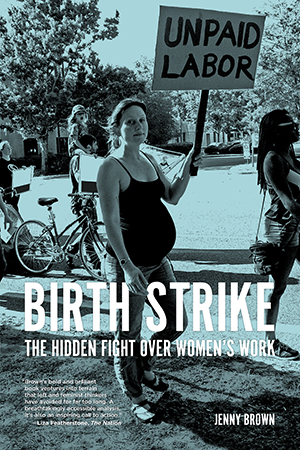By David Rosen
New York Journal of Books
April, 2019
Is a baby a commodity? Is pregnancy and childbirth work? Is raising a
child a job? These are among the provocative questions that inform Jenny
Brown’s study, Birth Strike: The Hidden Fight over Women’s Work.
Brown
is a feminist without sentiment, a Marxist without humanism. In this
well-researched work, the author seeks to strip away all sentiment from
people’s—especially women’s—understanding of the economic role of the
domestic services women perform. She sees such service as a form of
undervalued and unpaid labor. These services include pregnancy and
childbirth, rearing a child and all the domestic chores required to
maintain a household, and taking care of the elderly and infirmed. As
the old saying goes, a woman’s work is never done.
This
argument is compounded by the book’s underlying thesis, the “baby bust.”
She reminds readers that during the post WW-II era of the “American
Dream” “the wages of one full-time male breadwinner” was enough to
support a wife and kids, but now “two breadwinners are necessary to
support a family.” In the face of this historic change, Brown argues,
“women are deciding to have fewer children.”
Brown identifies
two significant consequences of this development. First, corporate and
political “elites are foretelling economic doom if women don’t step up
reproduction.” She quotes a conservative writer who asserts, “declining
birth rates constitute a problem for the survival and security of
nations . . . in the broadest existential sense of national security.”
Second, she stresses that the elites are using the power of the state,
including the Supreme Court, to restrict a woman’s right to an abortion
and limit contraception and birth control information (especially for
young girls). The outcome of these developments is a decline in
fertility rate.
The decline in the fertility rate is occurring
at a time when life expectancy has significantly increased. Brown notes
that in 1900, U.S. life expectancy was only 47 years and by 2018 it has
jumped to 79 years. Compounding this picture, the Guttmacher Institute
reports that nearly two-thirds (62%) of all women of reproductive age
use a contraceptive and nearly all women aged 15–44 who have had sexual
intercourse used at least one contraceptive method. Equally significant,
between 1991 and 2014, the teen birthrate fell by nearly 40 percent, to
24.2 births per 1,000 females from 61.8 births, due to sex ed and use
of contraceptives.
Embracing a traditional Marxist analysis,
Brown argues that women are part of the “reserved army of labor.” She
repeatedly reminds readers that conservative policymakers promote
anti-abortion and anti-birth-control policies in order to promote an
increase in the birth rate. The increase would help foster cheap labor.
She details her critique through extensive discussions of birth rates
and women’s work in terms of immigration, race, and labor practices.
She
also makes clear that the U.S. is not alone facing the
“below-replacement birth rate”; other countries facing a similar decline
include China, Japan, Germany, and the UK. She insists that “the fight
over the birth rate is mainly aimed at extracting another type of cheap
labor: the labor of bearing and rearing children.”
Amidst her
rigorous analysis, one small question comes up. In a chapter reviewing
the history of the debate over the birth rate, she notes that in the
early 20th century, leading radical socialists like Rosa Luxemburg,
Clara Zetkin, and V. I. Lenin argued against what they believed was the
moderate socialist position promoting the “birth strike” to contest
capitalism.
While apparently intellectually and politically
identifying more with radicals, Brown argues: “A birthrate slowdown or
strike, accompanied by feminist organizing and protest, might pressure
the power structure to provide better working conditions for
reproductive work, but the problem isn’t too many children to being
with.”
Drawing on the experiences of other advanced Western
society, Brown recommends that the U.S. needs to introduce a national
health care program, free abortion on-demand and birth-control,
universal free childcare (and eldercare), parental leave for all, and a
shorter work week. It’s unlikely that a birthrate strike will do much to
realize these important goals.
David Rosen’s most recent book is Sex, Sin & Subversion: The Transformation of 1950s New York’s Forbidden into America’s New Normal. His articles and book reviews have appeared in such diverse venues as Salon, Black Star News, Brooklyn Rails, Huffington Post, CounterPunch, Sexuality and Culture, The Hollywood Reporter, and others.







